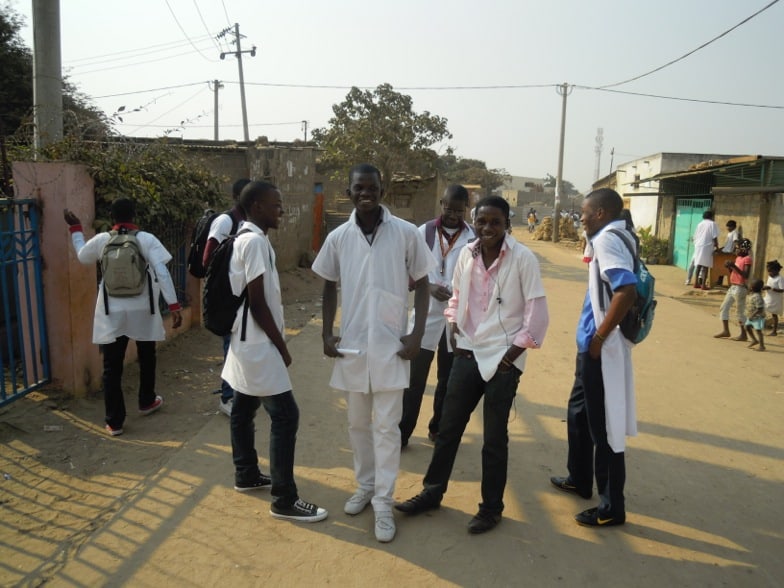Gina lay on a mattress in her room, the drip stuck in her hand, feeling “very feeble”. The sister of one of my key informants, she was but one of the many victims of the ‘fainting wave’ that swept through middle schools in Angola from April to September 2011. The desmaios (faintings) started in two polytechnic schools in the capital, Luanda, where I was carrying out my fieldwork, but then quickly spread through the entire city and eventually to other provinces of the country. It affected scores of teenage girls in middle and high schools — usually 20 to 100 ‘victims’ per episode — but also, in a few cases some male students and teachers. Victims, like Gina, typically reported a “horrible smell”, a feeling of cold, an unexplained mist in the corridors of their respective schools, shortness of breath, and loss of consciousness.
Following the statements of the first ‘victims’ at the technical middle school in Nova Vida, which reported they had smelled a gas, the authorities and the media propagated the idea of an unknown gas, and blamed the events on unknown evildoers. Something of an overreaction ensued: ‘victims’ were carted off in ambulances to isolation wards, with blood tests taken, though ultimately only saline drips were administered. The police laboratory was ordered to do forensic tests for the gas, while the criminal investigation police searched for the ‘evildoers’. Entry checks with armed police units and canine brigades were set up at most middle schools in Luanda, with students searched, and any items of cosmetics confiscated.
The ‘evildoer’ theory was then appropriated and instrumentalised by chief ideologues of the ruling MPLA party, such as Bento Bento, first party secretary of Luanda, who deplored in the state media the ‘general climate of instability’, and demanded ‘vigilance’ from all citizens to denounce and ‘unmask the evil-minded individuals (indivíduos malfeitores) at the service of crime and interests alien to the Angolan people’. He then added that he had no doubts that the same people – which ‘mobilise the youth to realise acts that are punishable by the penal code in force in the country, such as demonstrations of public disorder (arruaça), intrigue, and offence to [government] entities’ – were also practicing those criminal acts in the schools. The fainting wave was thus immediately connected to other current events, such as anti-government youth demonstrations that had recently started in Luanda.
The popular reception followed the theory of the ‘unknown gas’, and also ascribed a ‘technical’ cause and political intentionality to the events — but it questioned the official reading of the story. As Gina’s sister, Bela, said, “this will only get worse ahead of the elections”. Indeed, such went the reasoning of many, if Angola had one of the most efficient internal security services in the world — the former DISA/Segurança, trained by Soviet and East German instructors in the 1980s, rebranded as SINFO and equipped with Israeli technology today — how come the authors of the crime had not been apprehended yet? Furthermore, who could import such a gas? Surely only the Ministry of Interior! In fact, thus claimed another explanation, ‘they’ were testing a crowd control gas on children ahead of the elections.
There is someone who is doing this. OK, there are things that just happen, but this? It has to be a person. We don’t believe that it could be the students who are taking [the gas to school] — they [the authorities] say it’s the kids. Now it is not even permitted to take lipstick, perfume, cream inside. So this person jumped the wall, put on the bata [school uniform coat] like the others. It is not possible that it is a student who is doing this. It can only be a [malevolent] person who is behind this. There is no other reason, no other justification for this. No one knows, even the segurança do not know. (Gina, Bairro Nocal, 02.08.2011)

Cases of collective fainting have been documented widely across various cultural contexts and diagnosed by psychologists as ‘mass hysteria’; they are also a popular topic of fiction and media reporting. The symptoms presented by the ‘victims’ of the fainting in Angola, as well as the fact that it affected predominantly teenage girls, are absolutely conform to that biomedical/psychological explanation.
Anthropologists tend to interpret certain social phenomena as metaphors for something else: vampire rumours in Puerto Rico are, in this logic, ‘a popular commentary on modernity and its risks as they are perceived’ (Derby, 2008: 292); a Satanism scare in 1980s South Africa is a moral panic that gripped white South Africa as ‘a response to social change, a consequence of the fear of apartheid’s end’ (Falkof, 2012: 6). Similarly, the epiphenomenon of mass fainting, collective hysteria, etc. has been diagnosed as the ‘somatisation of a pathology in the body politic’ (Kroeger, 2003: 234, 254; see also Green, 1994: 248).
My first, instinctive reaction to the events, too, was to interpret it in James Scott’s analytic as an act of resistance (Scott, 1990), of ‘speaking the unspeakable’ — especially because there is often in Angola a perceived ‘impossibility’ to talk about politics and the ‘dark deeds’ of the government during the civil war. However, as Sanders justly points out, this line of interpretation has somewhat become ‘anthropological orthodoxy’ because it conforms, in its ‘intuitive plausibility, seductiveness and persuasiveness’, with ‘broader anthropological sensibilities’, i.e. our innate sympathies for the powerless (Sanders, 2008: 108–09).
Much as the literature on moral panics is inspiring, it does require somewhat of an analytical leap to make authoritative statements about the ‘real’ underlying causes of a social phenomenon. I, for one, feel ill at ease claiming the interpretative authority to explain its cause as ‘somatisation’ of an earlier trauma. However, what I think we can do, backed by solid ethnographic research, is to make statements about the reactions to such an event, and how these are informed by larger socio-political dynamics at play.
In the Angolan case, the reception of the crisis is indicative of the imaginaries of the state that circulate, and that ultimately reproduce hegemony, while the handling of the crisis tells us about the capacities of the state, thereby helping us disaggregate the monolithic ‘state’.

First, the political intentionality behind the events was rarely doubted: be it ‘enemies of peace and stability’ or the government itself that was using the gas, there had to be someone with sinister motives behind it. The official discourse that instrumentalised the case to call for ‘vigilance’, reinforced the dominant narrative of peace and stability (Schubert, forthcoming). However, the seemingly ‘subversive’ interpretation of the government’s ill intentions did not undermine, but in fact reinforce ‘the omnipotent presence of the ruling party elite, and its ability to deploy devastating “state power” at will’ (Fontein, 2009: 388). Popular theories about the malfeitores as agents of the state security service thus acted as a critique that ‘questions, yet paradoxically at the same time legitimates, state power’, indicating the ‘inherent dialectical structure of hegemonic processes, blurring any clear demarcation between “state” and “challenger” and calling into question approaches to popular discourse as “resistance”’ (Silverstein, 2002: 646).
Second, the belief in an evil intentionality is indicative of the paranoid disposition (Fassin, 2008) of Angolan politics in general. However, rather than just reiterating the often-heard trope that “Angolans are a coward people” because “the Angolan, already in his mother’s belly, is fed this fear” — regularly given as the reason why there’s little expression of political dissent — the paranoia transcended the boundaries we commonly draw between ‘the people’ and ‘the state’, further pointing to the dynamic, dialectic nature of a lived hegemony. I interviewed Dr André Soma (13.09.2011), the provincial director of education about this matter, and asked him whether he thought it could be a case of mass hysteria, perhaps inspired by television. He said for other panics this may be the case, but “the desmaios are a reality whose objective could be political, could be social, or who knows, could also be economic”.
Actors normally seen as ‘agents of the state’ such as the provincial director of education himself were anxiously waiting for the verdict of the “competent authorities”.
Thus, as a third point, the handling of the events allows us to say something about the capacities of the state. Contrary both to popular perception and — at least some — scholarly analyses of ‘neo-authoritarian regimes’ that perceive a regime like Angola’s as monolithic, a variety of state actors haphazardly responded to the crisis, thereby forcing us to question the unity of form and purpose we often ascribe to ‘the state’ (cf. Krohn-Hansen, 2008). Indeed, while the Ministry of Health doggedly pursued the theory of an unknown toxic gas that caused the teenage students to faint, the fainting wave ultimately only ebbed down when a psychiatric task force headed by Dr Rui Pires — one of the only three trained clinical psychiatrists in Angola at the end of the war — imposed a media blackout and put a stop to the entry checks by armed police at the schools. Nonetheless, the common invocation of “orientations from above” (orientações superiores) also eloquently speaks to the power and persistence of the fiction of the state among its very diverse actors.
Works cited
Derby L (2008) Imperial Secrets: Vampires and Nationhood in Puerto Rico. Past & Present 199(Supplement 3): 290–312.
Falkof N (2012) ‘Satan has come to Rietfontein’: Race in South Africa’s Satanic Panic. Journal of Southern African Studies 38(4): 1–15.
Fassin D (2008) The embodied past. From paranoid style to politics of memory in South Africa. Social Anthropology 16(3): 312–328.
Fontein J (2009) Anticipating the Tsunami: Rumours, Planning and the Arbitrary State in Zimbabwe. Africa: Journal of the International African Institute 79(3): 369–398.
Green L (1994) Fear as a Way of Life. Cultural Anthropology 9(2): 227–256.
Kroeger KA (2003) AIDS rumors, imaginary enemies, and the body politic in Indonesia. American Ethnologist 30(2): 243–257.
Krohn-Hansen C (2008) Political authoritarianism in the Dominican Republic. New York, N.Y.: Palgrave Macmillan.
Sanders T (2008) Buses in Bongoland Seductive analytics and the occult. Anthropological Theory 8(2): 107–132.
Schubert J (2015) 2002, Year Zero: History as Anti-Politics in the New Angola. Journal of Southern African Studies 41(4)
Scott JC (1990) Domination and the Arts of Resistance. Hidden Transcripts. New Haven, London: Yale University Press.
Silverstein PA (2002) An Excess of Truth: Violence, Conspiracy Theorizing and the Algerian Civil War. Anthropological Quarterly 75(4): 643–674.




